Abstract
The invaluable meteorological observations for a late autumn tropical cyclone that came very close to Hong Kong, namely, Nalgae in November 2022, are documented in this article. In particular, the dropsonde data for two consecutive days for this late season storm close to Hong Kong are presented. Meteorological data revealed that while Nalgae appeared to be rather weak from the meteorological satellite image under the cool sea surface water and the cool and dry northeast monsoon, it still maintained considerable intensity near the lower-boundary layer and managed to bring gale to storm force 10 min mean winds over many places in Hong Kong, necessitating the issuance of a gale or storm wind signal in November since 1972. The consideration in the issuance of the warning signal in Hong Kong and the difficulty in numerical weather prediction (NWP) model in forecasting Nalgae are also discussed in this article.
1. Introduction
The tropical cyclone season in Hong Kong occurs between May and October every year. It is rather rare to have tropical cyclones affecting Hong Kong in late autumn and winter. The closest example would be Rai, documented in [1]. Since records began in 1946, there have only been 13 tropical cyclones necessitating the issuance of tropical cyclone warnings in November in Hong Kong. Among them, only two required the issuance of gale or storm wind signal, namely, Super Typhoon Pamela in 1954 and 1972.
In November 2022, severe tropical storm Nalgae moved very close to Hong Kong, necessitating the issuance of gale or storm wind tropical cyclone warning signal again since 1972. It was not an intense tropical cyclone, but it managed to move over the rather cool sea (the northern part of the South China Sea) and maintained considerable intensity to affect Hong Kong. Nalgae is also special in that it made landfall over Southern China in late autumn. According to the Meteorological Bureau of Zhuhai and the best track data of the Hong Kong Observatory (HKO), it was the first tropical cyclone making landfall over Zhuhai, China, in November since records began in 1961. The course of Nalgae is a very special case and it deserves to be documented.
The forecast of a tropical cyclone affecting Southern China in autumn has been known to be notoriously difficult. The interaction between the northeast monsoon and the tropical cyclone makes the track of the cyclone highly variable and very complicated. Another difficult factor is the cooling effect of the northeast monsoon and the rather cool sea surface water over the northern part of the South China Sea. The vertical shearing effect associated with the monsoon would also tend to make the tropical cyclone weaker as it moves towards Southern China. The tropical cyclone needs to overcome these unfavorable factors in order to move north to the South China coast. As a result, it is very challenging for numerical weather prediction (NWP) models to accurately forecast the track of and intensity changes in the cyclone to support the tropical cyclone warning services.
This paper serves to document the course of Nalgae, the invaluable meteorological observations for a late autumn tropical cyclone, and the performance of NWP models in forecasting this cyclone. There are two main novel features of this paper.
Firstly, there were rather limited meteorological observations for a tropical cyclone affecting Southern China 50 years ago. Nowadays, there are more sources of observations. Ground-based, remote-sensing meteorological equipment, such as weather radars and lightning location systems, provides more observations. In particular, the HKO, the meteorological authority in Hong Kong, in collaboration with the Government Flying Service of the Hong Kong Government, conducts dropsonde flights for tropical cyclones within the Hong Kong Flight Information Region. In the case of Nalgae, it is the first time that dropsonde observations are available for a tropical cyclone close to Hong Kong in late autumn. These observations will be analyzed in detail.
Secondly, the NWP models became more sophisticated after 50 years. There are ensemble prediction systems (EPSs) providing different forecast scenarios for the tropical cyclone. This paper has a section discussing the performance of NWP models in this case. Emphasis would be made on the performance of EPS and the short-term forecasting of the track of Nalgae. The latter is particularly critical in the operation of the tropical cyclone warning service as the location and intensity of the tropical cyclone near the South China coast are essential for deciding which tropical cyclone warning signal should be issued in the near term.
2. History of Nalgae
The track of Nalgae is given in Figure 1a. Nalgae formed as a tropical depression over the western North Pacific, about 1210 km east-southeast of Manila on 27 October 2022. Moving west-northwestwards, it intensified during the following two days. Nalgae developed into a severe tropical storm on 29 October and moved across the central part of the Philippines. It entered the central part of the South China Sea on 30 October and slowed down. Nalgae turned to move north-northwestwards on 31 October, reaching its peak intensity with an estimated sustained wind of around 60 knots near its center. Under the influence of rather cool sea surface water over the northern part of the South China Sea (Figure 1b), Nalgae weakened gradually when it continued to edge closer to the coast of Guangdong. However, it still remained a tropical storm, with estimated sustained wind of around 45 knots near its center when it came closest to Hong Kong in the early morning on 3 November. Nalgae skirted around 40 km south-southwest of the HKO Headquarter. It then weakened into a tropical depression afterwards and made landfall over Zhuhai, China. Nalgae finally degenerated into an area of low pressure over the western part of Guangdong on the morning of 3 November.
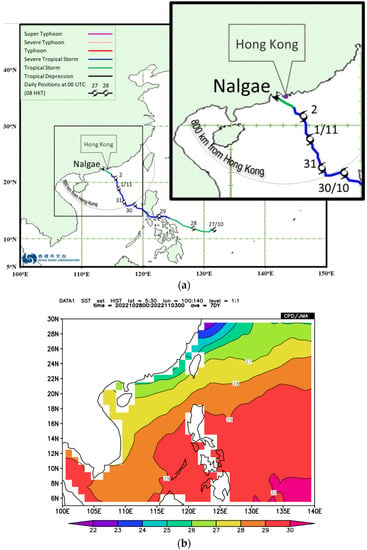
Figure 1.
(a) is the provisional track of Nalgae and (b) is the average sea surface temperature over the South China Sea and the western north Pacific between 28 October and 3 November 2022, based on COBE-SST dataset from Japan Meteorological Agency (JMA).
3. Dropsonde Observations
Two dropsonde flights were conducted on 1 and 2 November 2022 when Nalgae was within the Hong Kong Flight Information Region. The winds below 50 m, together with the false color meteorological satellite images around the times of the flights, are shown in Figure 2. During the first flight, namely, around 07 UTC on 1 November 2022 (Figure 2a), convection was still rather intense and active around Nalgae’s center. At that time, a sonde near the center recorded wind of around 60 knots at 10 m height, confirming that Naglae, at that time, was in the severe tropical storm category. During the second flight, around 02 UTC on 2 November 2022 (Figure 2b), convection was much weaker near the center and it was mainly sheared to the north and northeast of the center as a result of the cooler sea surface temperature and the vertical wind shear. However, though the system appeared to be rather weak from the meteorological satellite image, a sonde still recorded 50 knots at a height of 10 m, indicating that Nalgae was still near the lower boundary of the intensity of a severe tropical storm. Such data would be useful in the study of satellite image rules for determining tropical cyclone intensity, especially for a weakening one, in the South China Sea.
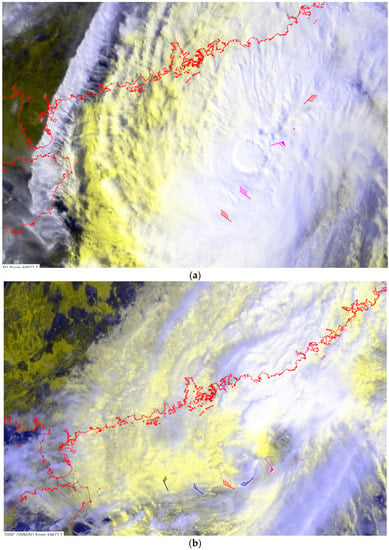
Figure 2.
Dropsonde data (winds below 50 m) overlaid on false-color satellite imagery at (a) around 0700 UTC on 1 November 2022 and (b) around 0200 UTC on 2 November 2022. The satellite imagery was originally captured by Himawari-8 Satellite (H-8) of Japan Meteorological Agency (JMA).
Apart from wind, the dropsondes provide vertical profiles of equivalent potential temperature, which are shown as the contour plots of all the sondes in Figure 3. For the flight on 1 November 2022 (Figure 3a), deep convection and warm core structure were still observed near the center. Significant cooling was observed on the second flight (Figure 3b), with much lower temperature near the center. The warm core at the center was also much less apparent. Only a small amount of the warm core structure was seen in the boundary layer near the center, namely, below 900 hPa. The shallowing of the warm core is also supported by the phase diagram (Figure 4) based on 0.5° Global Forecast System (GFS) analysis. Nalgae still possessed a deep warm core feature on 1 November. Subsequently, the warm core feature became shallower when Nalgae moved north and edged closer to the South China coast. The dropsonde observations of the two days show that the storm was weakening. However, convective activity was still sustained in the boundary layer of the storm, maintaining reasonable strength of the storm so that it may still pose some threats to the South China coastal region. The maintenance of the convective activity in the boundary layer is possibly related to the relatively high (around 26 degrees Celsius) sea surface temperature over the northern part of the South China Sea.
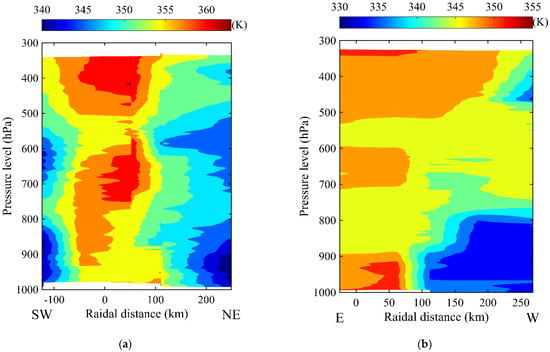
Figure 3.
Contour plot of equivalent potential temperature considering all the sondes at (a) around 0700 UTC on 1 November 2022 and (b) around 0200 UTC on 2 November 2022.
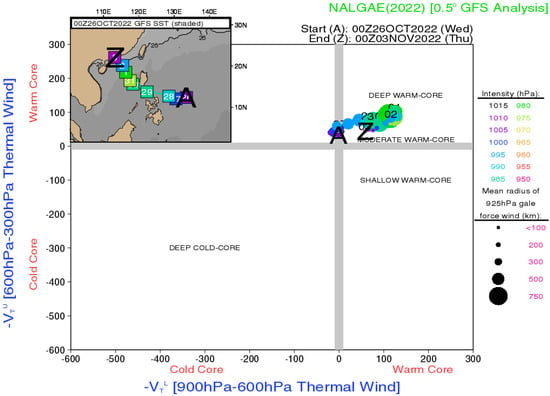
Figure 4.
The cyclone phase analysis [2] of Nalgae based on 0.50 Global Forecast System (GFS) analysis between 00 UTC 26 October 2022 and 00 UTC 3 November 2022. The inset gives the track of Nalgae and the model analysis Sea Surface Temperature field (SST, in degrees Celsius). The black “A” and “Z” indicates the beginning and the end of the life cycle of Nalgae. A marker is placed every 12 h. The shading of each marker indicates cyclone Mean Sea Level Pressure (MSLP) and the size of the circular marker within the phase space indicates the relative size (mean radius) of the 925-hPa gale force wind field. Positions at 0000 UTC are labeled with the day. Image courtesy of Cyclone Phase webpage (https://moe.met.fsu.edu/cyclonephase/, accessed on 12 January 2023).
The vertical profiles of the radial and tangential winds from the dropsondes are shown in Figure 5 and Figure 6 for the first and second flights, respectively. During the first flight (Figure 5), inflow was mainly seen in the boundary layer (below around 2 km) to the sondes to the northeast of Nalgae’s center, namely, the side of the combined effect of Nalgae’s circulation and the northeast monsoon. On the other hand, for the sondes to the southwest of the center (the Nalgae’s circulation), outflow was observed in the boundary layer. For the second flight (Figure 6), apart from the sondes very close the center (around 100 km), the inflow/outflow features were not significant, indicating that Nalgae was in a weakening trend. These observations add to the database of strengthening/weakening tropical cyclones in the northern part of the South China Sea based on dropsonde data, as reported in [3]. The dropsonde observations also show the asymmetry of Nalgae’s structure between the cooler northeast monsoon to the north/northwest and the convective activity over the sea/warmer air advection to the south/southeast. Such an asymmetric structure is a great challenge to the analysis and forecast of the NWP models and may not be captured well by the models, thus, casting doubt on the capability of the models on the forecast of the subsequent movement and intensity changes in the tropical cyclone.
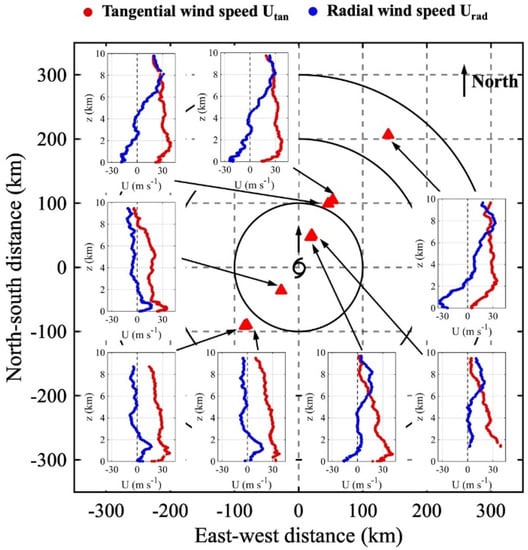
Figure 5.
Vertical profiles of tangential (red) and radial (blue) wind speeds in Severe Tropical Storm Nalgae at 0700UTC 1 November 2022. Tangential wind speed: anti-clockwise positive; radial wind speed: outflow positive. Red triangles represent dropsonde locations relative to the storm center.
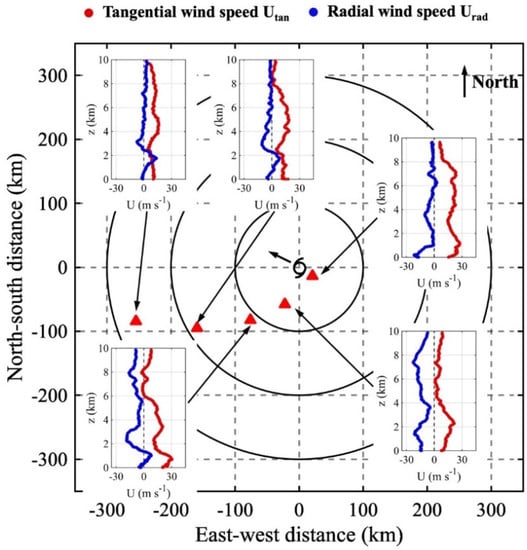
Figure 6.
Vertical profiles of tangential (red) and radial (blue) wind speeds in Severe Tropical Storm Nalgae at 0100 UTC 2 November 2022. Tangential wind speed: anti-clockwise positive; radial wind speed: outflow positive. Red triangles represent dropsonde locations relative to the storm center.
The potential temperature and equivalent potential temperature profiles from the dropsondes are shown in Figure 7 and Figure 8 for the two flights. As shown in Figure 7, the vertical profiles were mainly neutral during the flight on 1 November 2022, suggesting Nalgae was at least not in a strengthening stage. On 2 November 2022, Figure 8, a stable boundary layer (below 1–2 km) was observed in three sondes at least. This observation indicated that Nalgae should be in a weakening trend, probably because of the stabilizing effect of the cooler air from the northeast monsoon and the rather cool sea surface water of the northern part of the South China Sea.
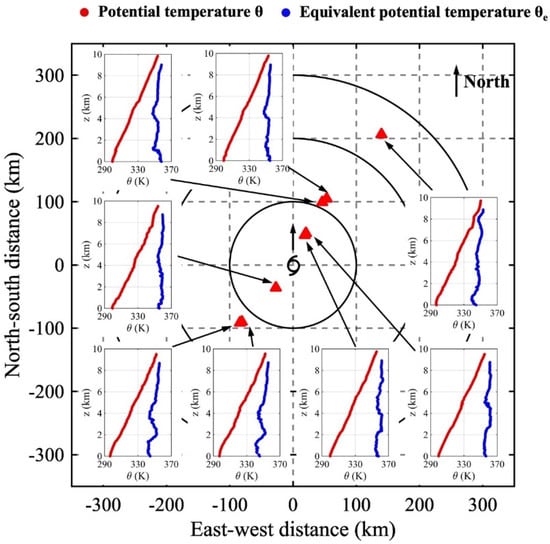
Figure 7.
Vertical profiles of potential temperature (red) and equivalent potential temperature (blue) in Severe Tropical Storm Nalgae at 0700 UTC 1 November 2022. Red triangles represent dropsonde locations relative to the storm center.

Figure 8.
Vertical profiles of potential temperature (red) and equivalent potential temperature (blue) in Severe Tropical Storm Nalgae at 0100 UTC 2 November 2022. Red triangles represent dropsonde locations relative to the storm center.
The boundary layer wind profiles, as revealed by the dropsondes, would have significant engineering applications, for instance, in wind engineering for the design of tall buildings. The profiles were fitted with the various models in the literature for tropical cyclones, namely, logarithmic law, Vickery model [4], Gryning model [5], Deaves and Harris model [6], and power law. The results are shown in Figure 9 and Figure 10. The fitting parameters are summarized in Table 1 and Table 2. There are two major observations:
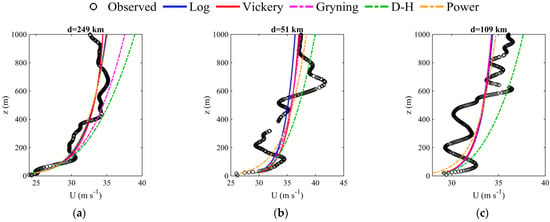
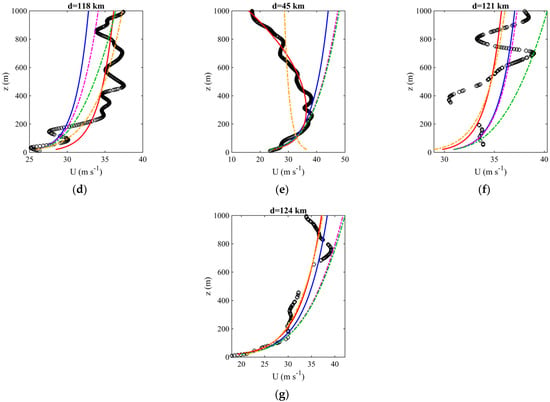
Figure 9.
Fitting of the vertical profiles of wind speeds in the lowest 1000 m in Severe Tropical Storm Nalgae at 0700 UTC 1 November 2022 to the wind profile models, including logarithmic law, Vickery model, Gryning model, Deaves and Harris model, and power law. d represents the distance to the storm center. Only dropsonde cases with sufficient measurements in the lowest 1000 m are shown (a–g).
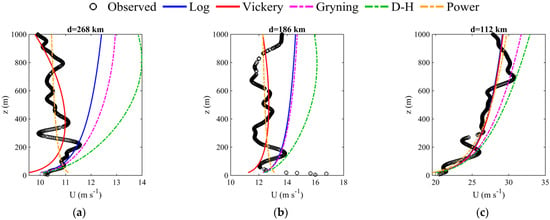
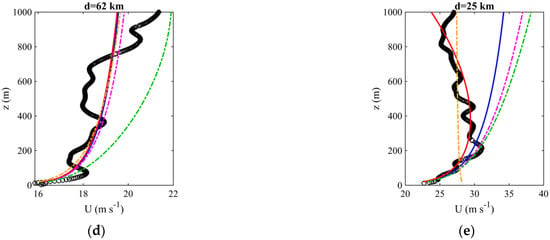
Figure 10.
Fitting of the vertical profiles of wind speeds in the lowest 1000 m in Severe Tropical Storm Nalgae at 0100UTC 2 November 2022 to the wind profile models, including logarithmic law, Vickery model, Gryning model, Deaves and Harris model, and power law. d represents the distance to the storm center. Only dropsonde cases with sufficient measurements in the lowest 1000 m are shown (a–e).

Table 1.
Fitting parameters for the wind profiles in the lowest 1000 m in Tropical Storm Nalgae at 0700UTC on 1 November 2022.

Table 2.
Fitting parameters for the wind profiles in the lowest 1000 m in Tropical Storm Nalgae at 0100UTC on 2 November 2022.
- (i)
- The sea surface roughness increases with increasing friction velocity in general. This is related to the wind waves and is in accordance with previous studies, such as [7,8].
- (ii)
- There are some cases with the jet height scale H* below 1000 m, which indicates there are low-level jet features in the wind profiles. Such low-level jet features are more predominant near the storm center (e.g., the two cases with d = 45 and 25 km), which were also noted by [9].
The observed low-level jet, which is also known as the supergradient boundary layer flow, is one of the salient features in tropical cyclones. It can be explained by the boundary layer spin-up mechanism [10]. The air in the tropical cyclone boundary layer loses its absolute angular momentum to the surface when it converges. At some inner radii of tropical cyclones (e.g., in the eyewall), where the loss rate of absolute angular momentum is small enough, the corresponding wind speed may be larger than that above the boundary layer, causing the boundary layer flow to be a supergradient [10]. Support for the existence of supergradient flow in the tropical cyclone boundary layer can also be found in observational studies, such as [11,12], and numerical simulations, such as [13]. The supergradient boundary layer flow contributes to the advection of momentum and heat into the tropical cyclone center and helps sustain the deep convection of the vortex [14]. It plays a crucial role in the intensification and structure of tropical cyclones and is a vital component in the tropical cyclone intensification paradigm of [15]. A detailed review of its role in tropical cyclone dynamics and thermodynamics can be found in [14]. The maintenance of the strength of Nalgae from the wind observations of dropsonde are consistent with the thermodynamic observations (e.g., Figure 3) of dropsonde, as discussed earlier on.
4. Radar, Satellite, and Lightning Observations
As Nalgae moved further north, it appeared to be much weaker from the meteorological satellite images. An image at around 08 UTC, 2 November 2022, is shown in Figure 11. Though the convection was rather weak near the center around that time, lightning was still observed in convection, with a discharge current of 8.0 kA. The weather-radar image also showed that the convection was sheared to the northeast. The observations of lightning and weather radar supported the dropsonde observations that convective activity was still maintained when Nalgae was close to the South China coastal region, possibly because of the still relatively high sea surface temperature in the northern part of the South China Sea. Nalgae may still pose a threat to the Southern China region, so a tropical cyclone warning could be necessary.
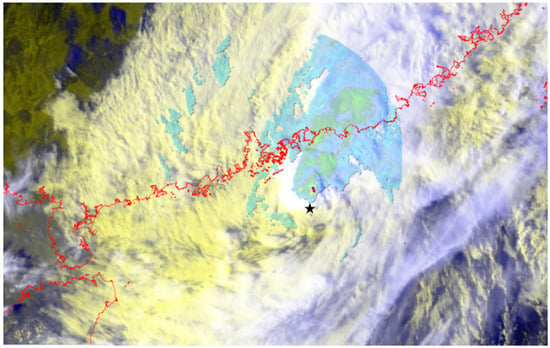
Figure 11.
Lightning (location shown in purple and red dots) overlaid on radar imagery and false-colour satellite imagery at 0800 UTC on 2 November 2022. The center of Nalgae is indicated by a black star symbol. The satellite imagery was originally captured by Himawari-8 Satellite (H-8) of Japan Meteorological Agency (JMA) and the lightning data is from the Hong Kong Observatory (HKO).
The weather radar also provided information on radial wind. An image from 13 UTC, 2 November 2022, is shown in Figure 12. This is based on the weather radar in Hong Kong, with a height of around 500 m above the sea surface. The elevation angle of the scan is 0.9 degrees and the range is 128 km. Gale force northeasterly flow was still observed along the South China coast when Nalgae was located at about 100 km to the south-southeast of Hong Kong. The combined effect of Nalgae and the northeast monsoon would still have the chance of bringing gale force winds to Hong Kong. This provides concrete information that a gale or storm wind warning signal would be necessary for Hong Kong.
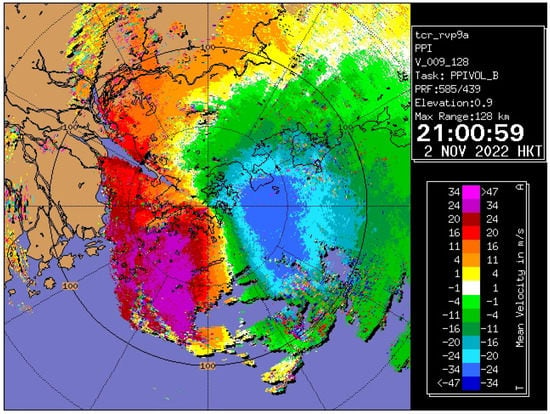
Figure 12.
Doppler radar image of Nalgae at 1300 UTC on 2 November 2022. The elevation angle of the scan is 0.9 degrees with a range of 128 km.
5. Observations in the Pearl River Estuary
The observation from a radar wind profiler in Hong Kong is shown in Figure 13. In the late evening of 2 November 2022 when Nalgae was approaching Hong Kong, winds at the boundary layer of the territory showed signs of strengthening, reaching around 50 knots between 1 and 2 km above the ground. Winds picked up over the mountains of Hong Kong (with a maximum height of 1 km above mean sea level) around that time.
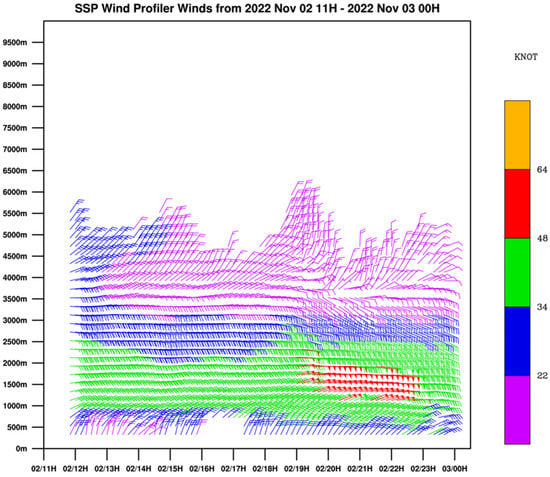
Figure 13.
Wind profiler measurements at Sham Shui Po, Hong Kong, on 2–3 November 2022. The x-axis is the local time in the format of DD/HH and the y-axis is the height.
The 10 min mean surface winds in the Pearl River Estuary are shown in Figure 14. Nalgae was very close to Hong Kong in the early morning of 3 November 2022, located at about 40 km to the south-southwest of the urban center of the territory. Gale to storm force winds were registered in many places in Hong Kong (Figure 14a). In particular, wind of around 50 knots was recorded on the small island of Cheung Chau in the southern part of Hong Kong. The time series of the mean wind and gust at this location is shown in Figure 15. Between around midnight and 3 a.m. on 3 November 2022, gale force wind was recorded at that station. The 3 s gust even reached hurricane level. A maximum wind of 34.3 m/s was recorded at about 1:35 a.m. on 3 November 2022. The prevalence of gale force winds in Hong Kong justifies the issuance of gale or storm wind tropical cyclone warning signal in Hong Kong.
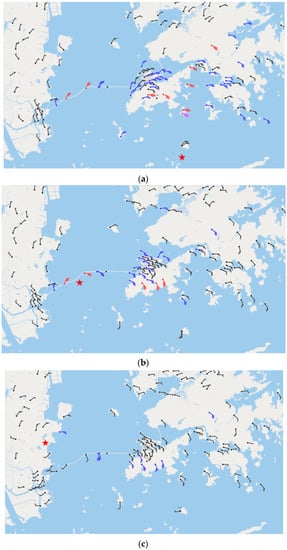
Figure 14.
Surface wind observation in the Pearl River Estuary at (a) 1750 UTC, (b) 1955 UTC, and (c) 2100 UTC on 2 November. The center of Nalgae is indicated by a red star symbol.
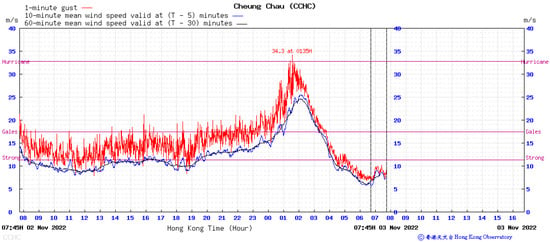
Figure 15.
Time series of 10 min mean wind speed (blue line), 60 min mean wind speed (black line), and 3-second gust (red line) recorded at Cheung Chau (elevation of anemometer: 99 m above mean sea-level) on 2–3 November (Hong Kong Time, UTC+8).
Nalgae then took on a north-westerly track to the western coast of the Pearl River Estuary. It moved across the Hong Kong–Zhuhai–Macao Bridge at around 4 a.m. (Figure 14b) and gale force winds were still registered at the bridge. At around 5 a.m., 3 November 2022, it made landfall over Zhuhai (Figure 14c). It had weakened quite a lot around that time. Only strong wind was observed to the north of the center. Gale force wind did not appear at that time. Nalgae then moved further west and dissipated over the western coast of Guangdong, marking the end of this very special course of this late autumn storm.
6. Performance of NWP Forecasts
The global NWP models were rather skillful on this occasion, as the birth of Nalgae over the western north Pacific was forecast 6–7 days ahead. Around that time, Nalgae was correctly forecast to move west to the Philippines. However, the major NWP models predicted that Nalgae would recurve around Taiwan and then moved northeast to Japan in the 9–10-day forecast (see Figure 16 for the model prediction by ECMWF, European Center for Medium Range of Weather Forecast, and NCEP, The United States National Centers for Environmental Prediction).
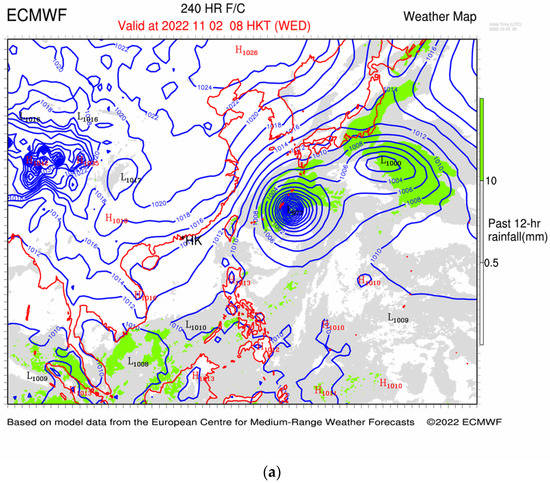
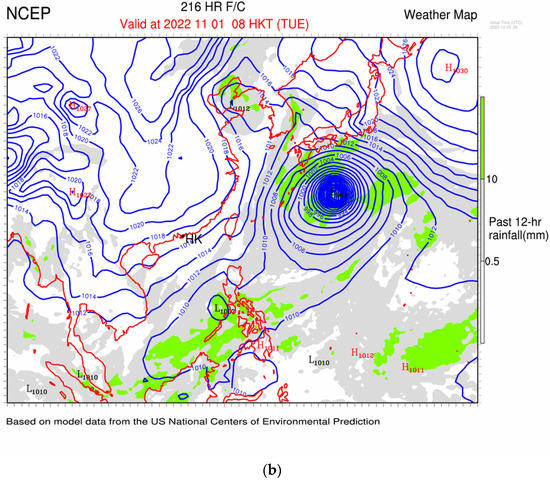
Figure 16.
(a) The 240-hour forecasts from the European Center for Medium Range Weather Forecasts (ECMWF) global model and (b) the 216-hour forecast of The United States National Centers for Environmental Protection (NCEP) at the surface, including precipitation (color shading) and pressure contours, from the run initialized at 0000 UTC, 23 November 2022.
As time progressed, the models began to forecast more accurately that Nalgae would move into the South China Sea and then tracked north. However, the EPS tracks of ECMWF were still very divergent (Figure 17a), making it difficult to give advance notice to the public about the possible approach of a tropical cyclone. The diverging track situation persisted as Nalgae continued to move towards the South China coast (Figure 17b). According to the EPS forecast tracks at that time, it would be possible for Nalgae to make landfall over the whole coast of Southern China and Hainan Island.
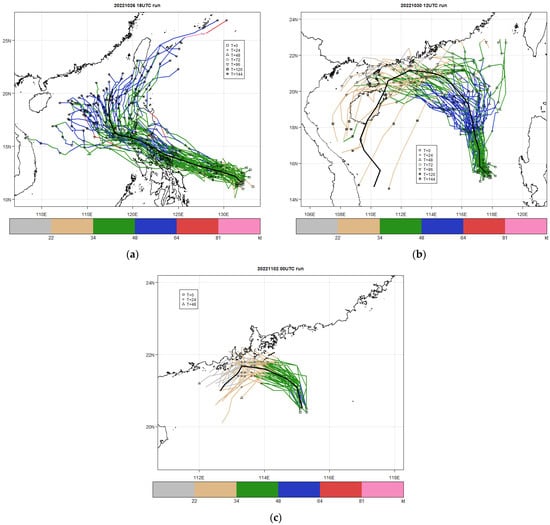
Figure 17.
The EPS forecast tracks from the European Center for Medium Range Weather Forecasts (ECMWF) global model, from the run initialized at (a) 1800 UTC on 26 October 2022, (b) 1200 UTC on 30 October 2022, and (c) 0000 UTC on 2 November 2022. The color indicated the maximum sustained wind of Nalgae (in knots).
Even for around 24 h before landfall, ECMWF’s EPS tracks were still very divergent (Figure 17c). In fact, the ECMWF deterministic model failed to forecast that Nalgae would make landfall at the western coast of the Pearl River Estuary (Figure 18b). On the other hand, the global model from the Japan Meteorological Agency (JMA) accurately predicted, with a lead time of 45 h, that Nalgae would make landfall near Macao and Zhuhai (Figure 18a). It also forecasted that gale force wind would be possible over Hong Kong later on 2 November and early on 3 November 2022. A similar story was provided by NCEP (not shown).
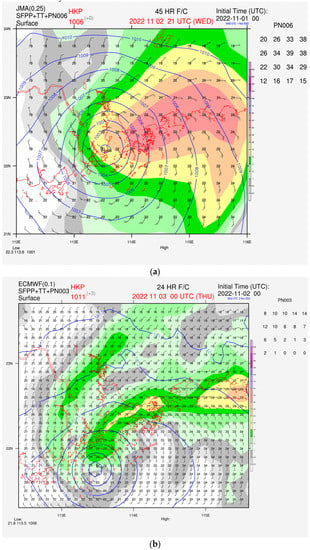
Figure 18.
(a) The 45-hour forecast from the Japan Meteorological Agency (JMA) global model and (b) the 24-hour forecast from the European Center for Medium Range Weather Forecasts (ECMWF) global model at the surface, including surface wind (wind barbs over the grid points), temperature (numbers over the grid points), precipitation (color shading), and pressure contours, from the run initialized at (a) 0000 UTC on 1 November 2022 and (b) 0000 UTC on 2 November 2022.
The forecast track errors of ECMWF EPS, deterministic forecast of JMA global model, and the HKO warning track for Nalgae over the South China Sea are shown in Table 3. Although the performance of ECMWF EPS was better for the 48 h and 72 h forecasts, the deterministic forecast of the JMA global model showed better performance in the 24 h forecast. For cross-track error, the performance of the HKO forecast was better in general, with a left bias of only 11 km for the 48 h forecast. The ECMWF was still a reliable source in formulating the forecast track and achieved good results in a statistical sense, but the individual model such as JMA is important in the short-term forecast (24 h forecast) in determining the weather warning strategy for the storm in the South China coastal region. There is not a single source of information from an NWP model that outperforms all the others. It is necessary to consider all the available NWP data sources.

Table 3.
Verification of TC track forecasts (direct position error, along track error and cross track error) from the European Center for Medium-Range Weather Forecasts ensemble prediction system (ECMWF EPS) and the global model of Japan Meteorological Agency (JMA) deterministic forecast and subjective forecast issued by the Hong Kong Observatory (HKO) (00 UTC on 30 October–12 UTC 2 November). For along-track error, negative (positive) indicates a slow (fast) bias. For cross-track error, negative (positive) indicates a left (right) bias.
The case of Nalgae vividly illustrates the difficulty for model forecasting of the movement and intensity of tropical cyclones in autumn. For the cyclone track, the complicated interaction between the northeast monsoon and the cyclone may not be correctly reflected in the models’ physical processes. For the cyclone intensity, the cooling effect of the sea surface water and the rather dry and cool northeast monsoon make too many variables for the intensity changes. The difficulty in intensity forecast reflects back on the difficulty in track forecast because the different intensities of the cyclone would have different levels of steering flow. If the cyclone is stronger, it may be steered by the subtropical ridge and the westerly trough at the middle troposphere. For a weaker cyclone, it may be mainly steered by the northeast monsoon. This may be the reason why ECMWF failed to forecast the landfall of Nalgae, even for 24 h ahead, as the system appeared weaker in the model and it might have been “pushed away” from the coast by the monsoon.
7. Conclusions
Nalgae was a legendary storm. Though it was not strong (severe tropical storm, or maybe a marginal typhoon, as analyzed by the China Meteorological Administration), it managed to overcome the cool sea surface water over the northern part of the South China Sea and the cool and dry northeast monsoon. It finally made landfall over the Pearl River Estuary and managed to bring gale to storm force winds to that region. As shown from the dropsonde observations, Nalgae was weakening in moving towards the South China coast, which is consistent with the phase diagram results, but convective activity was still maintained at the atmospheric boundary layer so that Nalgae had considerable strength to pose some threats to the Southern China coastal region. The maintenance of considerable strength for Nalgae appears to be related to the still rather high sea surface temperature over the northern part of the South China Sea in late autumn. With climate change, the sea surface temperature may get higher and such late season storms affecting the South China coast may become more frequent.
This paper documents the invaluable observations of Nalgae over the northern part of the South China Sea, in particular, the dropsonde observations for two consecutive days. The difficulty in the NWP model forecast was also documented. Nalgae was a great challenge to the operation of the tropical cyclone warning service to the Hong Kong public. Its eventual landfall over Zhuhai was a great surprise. It is hoped that this paper will rouse the interest of the meteorological community to further improve the forecasting of track and intensity of autumnal cyclones, particularly the late autumn ones, for the more effective operation of a public weather warning service.
Apart from an observational study, the present paper also discusses some aspects of the performance of NWP models in forecasting the movement of Nalgae. On average, EPS still provided a reasonable trend to the movement of the storm in terms of track errors in a statistical sense. However, the individual model may perform better at some time slots, such as JMA global model in the short term (24 h forecast), which is highly important in the provision of tropical cyclone warning services for the South China coastal areas.
Another study direction for Nalgae is the impact of the various observational data in the warning service. One aspect is whether the dropsonde data deployed 1–2 days before the actual landfall time could provide useful guidance for the subsequent TC motion or intensity variation in view of the diversity of the EPS tracks of EC. Further studies using the method of, for instance, CNOP [16] may be employed.
Author Contributions
P.-W.C.; writing—original draft preparation, C.-W.C. and J.H.: formal analysis, B.M.: data collection. All authors have read and agreed to the published version of the manuscript.
Funding
This research received no external funding.
Data Availability Statement
The dropsonde data are available upon request to the Hong Kong Observatory.
Conflicts of Interest
The authors declare no conflict of interest.
References
- Chan, P.W.; Choy, C.; He, J.; Li, Q. An observational study of Super Typhoon Rai, a very late-season typhoon necessitating the issuance of a tropical cyclone warning signal for Hong Kong in December 2021. Weather 2022, 77, 433–438. [Google Scholar] [CrossRef]
- Hart, R.E. A cyclone phase space derived from thermal wind and thermal asymmetry, Mon. Wea. Rev. 2003, 131, 585–616. [Google Scholar] [CrossRef]
- He, J.; Hon, K.K.; Chan, P.W.; Li, Q.S. Dropsonde observations and numerical simulations of intensifying/weakening tropical cyclones over the northern South China Sea. Weather 2022, 77, 332–338. [Google Scholar] [CrossRef]
- Vickery, P.J.; Wadhera, D.; Powell, M.D.; Chen, Y. A hurricane boundary layer and wind field model for use in engineering applications. J. Appl. Meteorol. Climatol. 2009, 48, 381–405. [Google Scholar] [CrossRef]
- Gryning, S.E.; Batchvarova, E.; Brümmer, B.; Jørgensen, H.; Larsen, S. On the extension of the wind profile over homogeneous terrain beyond the surface boundary layer. Bound. -Layer Meteorol. 2007, 124, 251–268. [Google Scholar] [CrossRef]
- Deaves, D.M.; Harris, R.I. A Mathematical Model of the Structure of Strong Winds, CIRIA Report 76; Construction Industry Research and Information Association: London, UK, 1978. [Google Scholar]
- Powell, M.D.; Vickery, P.J.; Reinhold, T.A. Reduced drag coefficient for high wind speeds in tropical cyclones. Nature 2003, 402, 279–283. [Google Scholar] [CrossRef] [PubMed]
- Zhao, Z.-K.; Liu, C.-X.; Li, Q.; Dai, G.-F.; Song, Q.-T.; Lv, W.-H. Typhoon air-sea drag coefficient in coastal regions. J. Geophys. Res. Ocean. 2015, 120, 716–727. [Google Scholar] [CrossRef]
- Giammanco, I.M.; Schroeder, J.L.; Powell, M.D. GPS dropwindsonde and WSR-88D observations of tropical cyclone vertical wind profiles and their characteristics. Weather. Forecast. 2013, 28, 77–99. [Google Scholar] [CrossRef]
- Smith, R.K.; Montgomery, M.T.; Nguyen, S.V. Tropical cyclone spin up revisited. Q. J. R. Meteorol. Soc. 2009, 135, 1321–1335. [Google Scholar] [CrossRef]
- Kepert, J.D. Observed boundary-layer wind structure and balance in the hurricane core. Part I. Hurricane Georges. J. Atmos. Sci. 2006, 63, 2169–2193. [Google Scholar] [CrossRef]
- Kepert, J.D. Observed boundary-layer wind structure and balance in the hurricane core. Part II. Hurricane Mitch. J. Atmos. Sci. 2006, 63, 2194–2211. [Google Scholar] [CrossRef]
- Zhang, J.A.; Marks, F.D. Effects of horizontal diffusion on tropical cyclone intensity change and structure in idealized three-dimensional numerical simulations. Mon. Weather. Rev. 2015, 143, 92–110. [Google Scholar] [CrossRef]
- Montgomery, M.T.; Smith, R.K. Recent developments in the fluid dynamics of tropical cyclones. Annu. Rev. Fluid Dyn. 2017, 49, 541–574. [Google Scholar] [CrossRef]
- Montgomery, M.T.; Smith, R.K. Paradigms for tropical cyclone intensification. Aust. Meteorol. Oceanogr. J. 2014, 64, 37–66. [Google Scholar] [CrossRef]
- Mu, M.; Duan, W.; Wang, B. Conditional nonlinear optimal perturbation and its applications. Nonlinear Process. Geophys. 2003, 10, 493–501. [Google Scholar] [CrossRef]
Disclaimer/Publisher’s Note: The statements, opinions and data contained in all publications are solely those of the individual author(s) and contributor(s) and not of MDPI and/or the editor(s). MDPI and/or the editor(s) disclaim responsibility for any injury to people or property resulting from any ideas, methods, instructions or products referred to in the content. |
© 2023 by the authors. Licensee MDPI, Basel, Switzerland. This article is an open access article distributed under the terms and conditions of the Creative Commons Attribution (CC BY) license (https://creativecommons.org/licenses/by/4.0/).